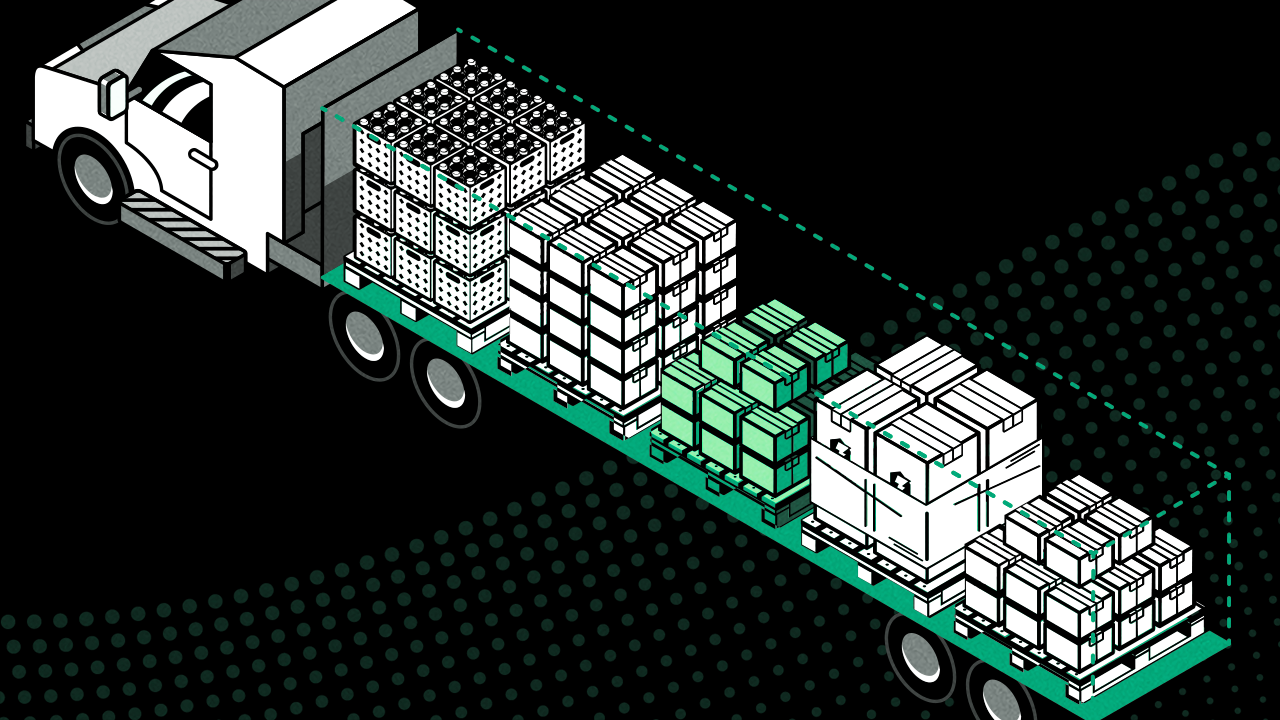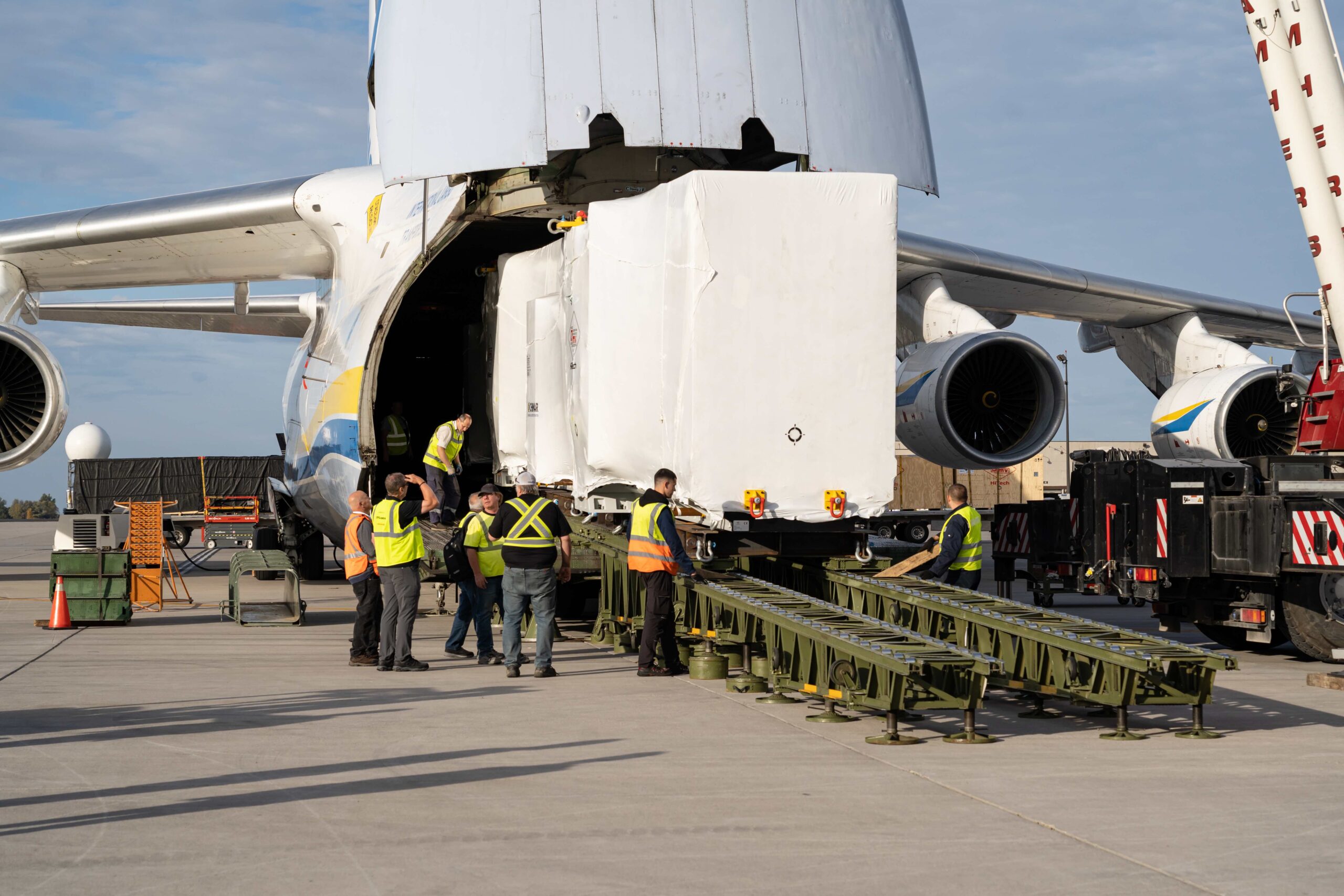Less than truckload (LTL) shipping is a cost-effective and efficient way to move orders that do not take up a full truck’s worth of space.
If you’re shipping six pallets or less and generally up to 10,000 lbs., LTL is a great option for your freight.
That said, determining when to use full truckload or LTL is only the beginning.
Not all LTL carriers have the same business model, and the best option for your freight will vary depending on where you’re located, where your freight is going, what you’re shipping and what is most important to you (service or cost).
In this article, you’ll learn:
- The differences between LTL and truckload carriers
- An overview of the LTL carrier market
- How hub and spoke LTL networks work
- About the 7 types of LTL carriers
- The pros & cons of each carrier type
- Five questions to ask when choosing an LTL carrier
LTL Carriers vs. Full Truckload Carriers
Compared to full truckload shipping, LTL’s core value is cost savings.
By consolidating smaller shipments from multiple shippers by destination, LTL carriers are able to provide the best possible service at the lowest cost.
But entering the LTL carrier market is no easy feat.
While they offer an efficient service, it is much more difficult to build a viable network to support carrier operations.
In full truckload shipping:
- The same driver picks up the shipment and delivers it straight through to the destination.
- A carrier can enter the full truckload market with as little as one truck.
In LTL shipping:
- LTL carriers use multiple trucks to transfer shipments between several regionalized terminals.
- To run a balanced and profitable network, LTL carriers need to build lane density between each terminal.
All of this requires significant resources and scale (i.e. capital expenditure), and as a result LTL carriers are typically larger than almost all full truckload providers.
Compared to the full truckload market, the barriers to entry into the LTL market are much higher.
LTL Carrier Market Fundamentals
Though many tend to be larger fleets, LTL carriers range in size — some provide national coverage, some cover specific regions, while others only cover a single metro area.
The LTL market is much more consolidated than the truckload market.
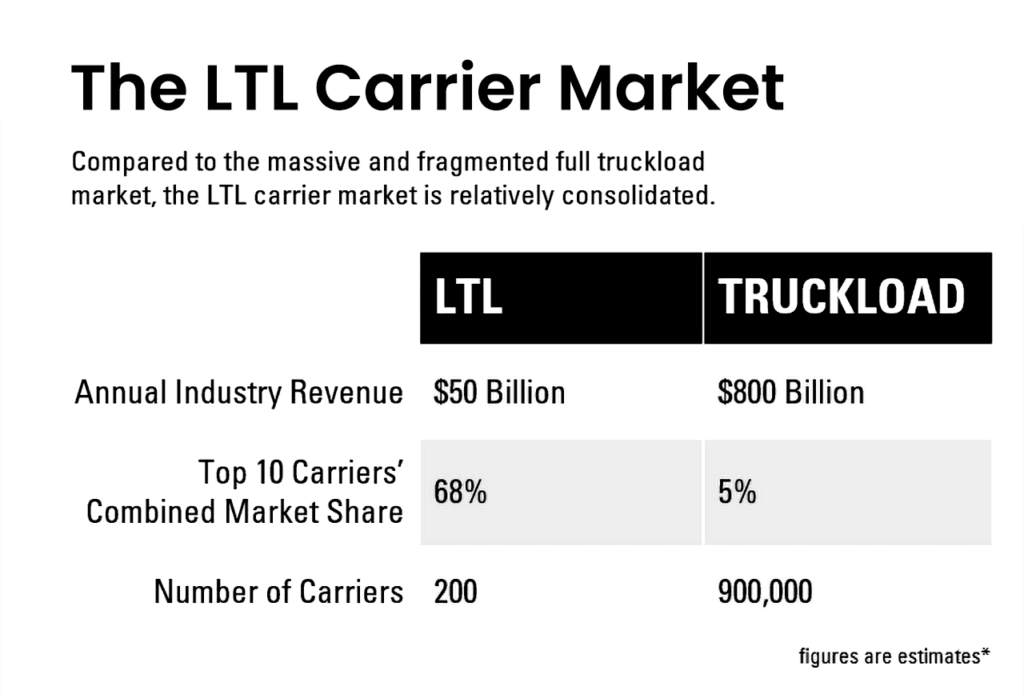
Generally speaking, this leads to much less volatility in pricing and capacity, though networks are not as flexible.
The U.S. LTL market is also a much smaller subset of the trucking industry.
In terms of revenue, it’s an approximately $50 billion market, while the wider U.S. truckload market is $875 billion.
In the truckload market:
- There are nearly 900,000 for-hire common carriers, 99.7% of which operate 100 trucks or less.
- The top ten full-truckload-focused carriers only claim about 5% of total industry revenue.
- The market is huge, with $875 billion in revenue.
In the LTL market:
- There are around 200 carriers.
- The top ten control about 68% of the market.
- The market is smaller, with approximately $50 billion in revenue.
One Carrier, Multiple Hubs: How an LTL Network Operates (in 5 Steps)
Though models vary by carrier type, many National LTL carriers operate on hub-and-spoke models.
A hub-and-spoke model means that shipments travel through a network of “hub” facilities where they are consolidated with other shipments, and “spoke” drivers handle first-mile pickups and final-mile deliveries.
Here’s an overview of how an average hub-and-spoke LTL network operates.
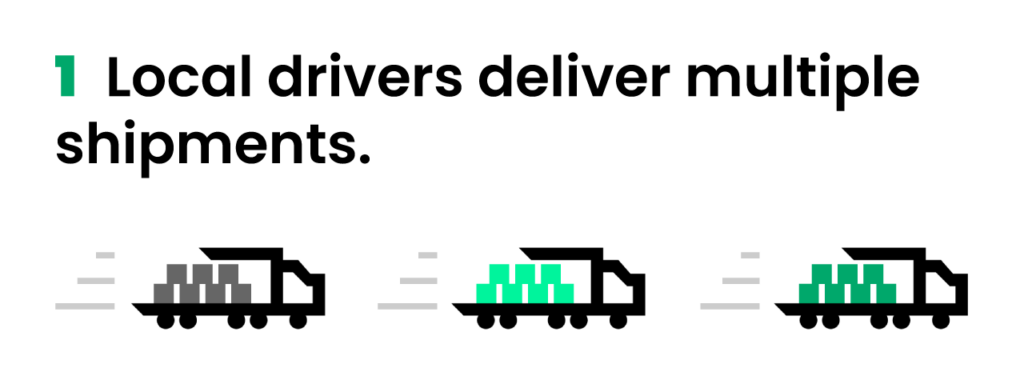
Local drivers (AKA city or pick-up and delivery (P&D) drivers) head out each morning to deliver shipments from their local terminal.
These shipments going out for delivery either arrived via linehaul from another terminal, or were local pickups made earlier by that local terminal.
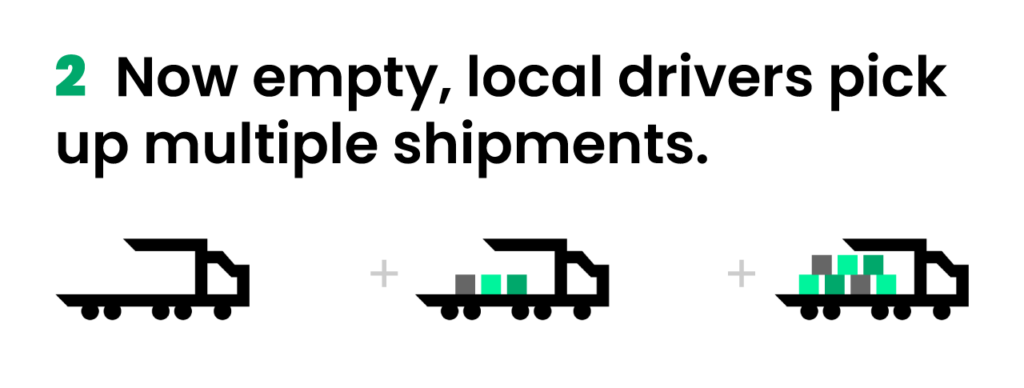
Once the local driver is empty, they will make pick-ups from various shippers in a loosely defined origin area, then return to their local terminal in the late afternoon or early evening.
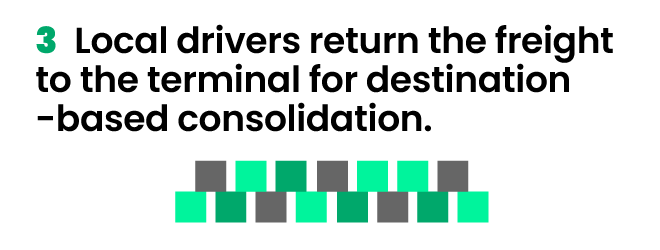
Once back at the local terminal, the LTL terminal will unload the local driver’s shipments, then re-consolidate them with other shipments from other local drivers based on the shipments’ final destinations.
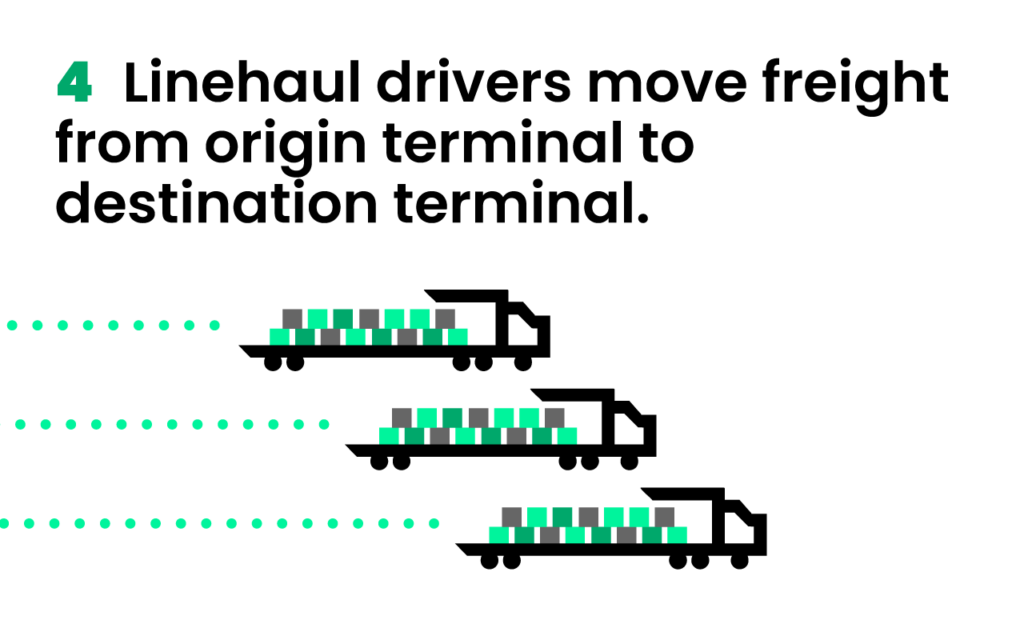
Dedicated linehaul drivers then haul a trailer of consolidated shipments from the origin terminal to the applicable destination terminal.
Depending on the carrier’s network, the product may stop at multiple terminals before reaching its destination terminal.
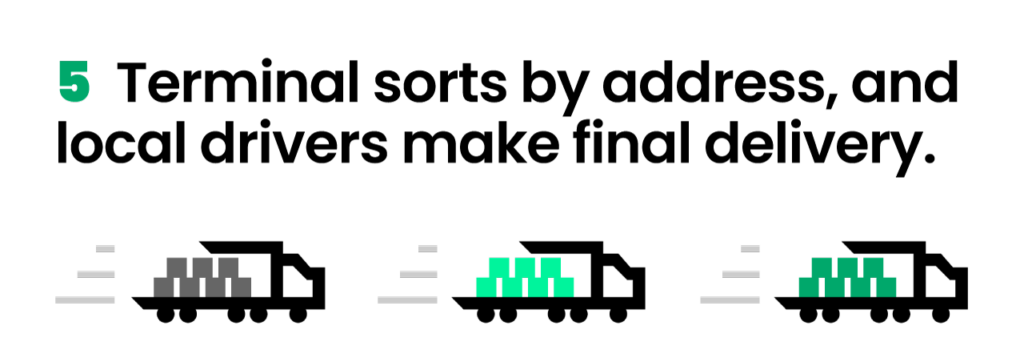
Once at the destination terminal, the terminal will unload the linehaul trailer, then sort the shipments by delivery address.
The next available local driver will take the shipments out for final delivery to the customer.
The 7 Types of LTL Carriers
Even though the LTL market has far fewer carriers than the full truckload market, there are several different business models, each creating a unique blend of cost, service and speed.
Most shippers work with several different LTL providers to create the right balance of capacity and rates.
There is no magic number — your ideal carrier mix will depend on your specific needs, but understanding each type will help you set a better strategy.
Keep in mind that each carrier’s network is different, and they may not cleanly fall into one category.
1. National LTL Carriers
National LTL carriers provide coast-to-coast and border-to-border coverage. They operate dense freight networks that usually run on a hub-and-spoke model of terminals and drivers.
Some carriers’ networks may have coverage voids where no service is provided — in these cases, they may rely on partner carriers to provide final delivery service.
National carriers are large, often publicly traded companies with sophisticated business operations. They are the most common and recognizable type of LTL carriers.
Examples: Estes Express Lines, R&L, Old Dominion Freight Line
When to use national LTL carriers:
With their large, expansive networks, it is generally a good idea to use at least one national carrier in your mix to maximize coverage.
Their density and scale can lead to competitive pricing in certain lanes, but the key benefit is coverage.
National carriers make it easier to consolidate and streamline your LTL freight — instead of finding the right carrier in each region, this offers a one-stop-shop approach. This is particularly beneficial for shippers that move LTL freight all over North America.
Potential drawbacks:
Bigger isn’t always better.
Though they may provide coast-to-coast coverage, each national carrier’s networks will have strengths and weaknesses — rates and service levels in certain lanes may not be as strong compared to more specialized carriers.
Also, if you are a smaller shipper with low volume, you’re a little fish in a big pond and it will be harder (or potentially impossible) to secure preferential pricing.
2. Multi-Regional LTL Carriers
Multi-regional LTL carriers service large areas made up of two or more regions. In terms of coverage, they fall between a national and a regional carrier (see #3).
Examples: AAA Cooper, Averitt Express, Dayton Freight Lines
When to use multi-regional LTL carriers:
This is a good way to split the difference between a national and a regional provider.
You can add increased coverage and capacity while still taking advantage of the carrier’s more focused network strengths.
Multi-regional carriers are a great option when you have shipments spanning a few states, but do not need full coast-to-coast coverage.
Potential drawbacks:
Though you can access the benefits of both national and regional carriers (wider coverage, more focused network), you also get some of the cons (you’re a small fish in a bigger pond, and if you have freight outside their coverage, you may need to use another provider).
3. Regional LTL Carriers
Regional LTL carriers service a group of states within a defined area.
They will typically have a strong presence and a dense network within their region, operating several facilities. Outside of their region, they generally do not offer coverage. They are a very common type of LTL carrier.
Examples: A Duie Pyle, Pitt Ohio, Ward Transport
When to use regional LTL carriers:
If you have freight picking up and delivering within a regional carrier’s coverage area, you may be able to access competitive pricing and higher service. This is especially true if you have consistent LTL freight in a regional carrier’s area.
Potential drawbacks:
It can be more difficult to manage which carriers service which regions, and if you have shipments outside of their coverage area, you will need to source another provider.
Also, compared to national carriers, regional carriers are usually smaller, and may not have as much capacity or as sophisticated technology.
4. Sub-Regional Carriers
Sub-regional LTL carriers service a distinct part of a region.
Examples: Southwestern Motor Transport, Pace Motor Lines
When to use sub-regional LTL carriers:
These carriers are a great option when you have LTL shipments that are not traveling long distances.
If you are within their service area, sub-regional carriers can offer competitive service and rates.
Since they tend to be smaller in size, it is more likely that you can secure preferential pricing for consistent volume moving within their service footprint.
Potential drawbacks:
Sub-regional carriers have a small coverage area, so they will likely only play a niche role in your LTL network.
5. Asset-Light LTL Carriers
Asset-light LTL carriers try to maximize their coverage area while minimizing the amount of trucks, drivers and terminals they own. They do this by relying on driver capacity of other truckload and LTL providers.
Asset-light carriers will usually complete long-haul hub transfers using intermodal or full truckload shipping, then outsource the final-mile deliveries to regional or sub-regional LTL carriers.
They are much less common than national, multi-regional and regional carriers.
Because asset-light carriers often use intermodal providers to connect pickup point to final destination, transit times are generally longer than typical LTL shipping.
Examples: Clearlane Freight, Frontline Freight
When to use asset-light LTL carriers:
By focusing on efficiency, asset-light carriers are one of the most budget-friendly options. When you want to have wide coverage, minimize the number of carriers you use and save the most money, they are a good option to look into.
Potential drawbacks:
Your product may be handled more often, pass through more than one carrier and may ride on the rail via intermodal. This will often add up to longer transits, more product handling and less control of your product while in transit.
6. Load-to-Ride LTL Carriers
Load-to-ride LTL carriers focus on bulky and/or long-range shipments.
These carriers operate somewhat similar to multi-stop truckload carriers, in that one driver will pick up multiple shippers’ freight and deliver them straight through — there are less (or no) stops at terminals, and more direct delivery routes.
Additionally, long-range shipments eliminate the need for excessive product handling, which is an added benefit for shippers with sensitive commodities.
Example: Sunset Pacific Transportation, iShared
When to use load-to-ride LTL carriers: Whenever you have a long-range shipment (crossing over multiple regions) and are willing to be flexible to fit the carriers’ schedule, load-to-ride carriers can offer competitive rates, quick service and less product handling.
Potential drawbacks: Exact capacity and coverage is much more limited. Load-to-ride carriers will be a niche provider, adding value only on the opportunities that sync well with their network.
7. Reefer LTL Carriers
Reefer LTL carriers operate similarly to load-to-ride carriers, in that they focus on long-range shipments and rarely transfer product in terminals.
The main difference is that reefer LTL commodities must all have the same temperature requirements.
Examples: H&M Bay, DTS
When to use reefer LTL carriers:
Apply the same logic as load-to-ride carriers, but for temperature sensitive freight.
Potential drawbacks:
Due to strict food safety and temperature-sensitive product requirements, there is a very limited selection of carriers equipped to transport refrigerated commodities. Finding coverage and capacity for this service may be limited.
How to Choose an LTL Carrier That Works for You: Answers to 5 Key Questions
If you’ve made it to this point, you probably have an idea of when you’ll want to work with each type of carrier.
But that’s only half the battle.
How do you know which specific carrier is the right one for your freight needs?
Try asking yourself these questions to evaluate your needs and feel confident in your carrier choice.
Is the best LTL carrier always the cheapest?
In short: No.
One of the most common mistakes LTL shippers make is to base their carrier decisions purely on cost.
Even if the price tag for a given shipment is the cheapest, it could still end up costing you more in the long run if it causes are damages, delays or other disruptions to your operations.
Now this is not to say that the cheaper options you see when you get an LTL quote are necessarily from “lower-quality” carriers.
In fact, you’ll sometimes get the best service available with the cheapest rate because your needs match up to that carrier’s capabilities so well.
What factors beyond cost should I consider when choosing an LTL carrier?
Price is just one factor to consider when choosing a carrier to move an LTL shipment for you.
Some other things to consider include:
- Network Density
How many trucks do they have operating in lanes you need covered? Do they service the locations of your facilities directly? - Available Equipment
Do you need refrigerated trailers? How about lift gates? What are their surcharges for using this equipment? - Service Offerings
Are they willing to deliver indoors? To residences? To meet your other accessorial needs? How much do they charge for these services? - Ease of Doing Business
How convenient is their digital platform? Are you wasting time struggling with it? Do their reps communicate clearly?
Can I tell how often my freight will change hands with a given carrier?
You likely won’t be able to answer this precisely, but there are some strategies you can use to make a pretty good estimate.
The best and easiest-to-obtain indicator of the number of stops your freight will make is the estimated transit time the carrier gives you when you quote your shipment.
Try quoting the same shipment in the same lane with two different carriers.
If they provide significantly different estimates, that’s a good sign the carrier with the longer time expects your freight to stop and get transloaded more frequently.
Another thing to keep in mind is that your freight won’t just be traveling between different trucks in your carrier’s own fleet.
LTL carriers’ service maps contain a combination of direct and indirect points:
- Direct points are nodes that the carrier services directly with its own equipment and drivers.
- Indirect points are nodes they outsource to other trucking companies.
Even the biggest LTL carriers use this mix of direct and indirect points, so it’s not at all a strike against a carrier if you know that they are doing so.
But it’s still worth thinking about, as it creates more uncertainty about the hands your freight is in.
Carriers don’t like to disclose where the indirect points are in their service area. However, if you ask their reps whether they service your lanes directly, they are more likely to give you a straight answer if it’s a “yes.”
How do I know if a carrier is less likely to damage my freight?
This one is even trickier to get a clear answer about — even though damages are a part of life in LTL shipping, carriers are understandably hesitant to admit that it happens to them.
This is a place where a 3PL can really help you out.
A benefit of having long-standing relationships with a carrier is that a 3PL will amass years’ worth of operational data that can tell them exactly what that carrier’s frequency of damage claims is.
The typical damage ratio we see for LTL carriers is 1-2%.
Should I work with a freight broker (3PL) to find an LTL carrier?
3PLs have a lot to offer LTL shippers regardless of your experience level.
In fact, 81% of shippers think working with 3PLs for at least some of their LTL freight is the ideal approach. Only 16% take this function fully in-house.
If you’re new to it, they can help you learn the ins and outs of carrier types, freight class, timetables and everything else.
And even if you’ve been shipping LTL for some time, they can still help you optimize and monitor your growing carrier network.
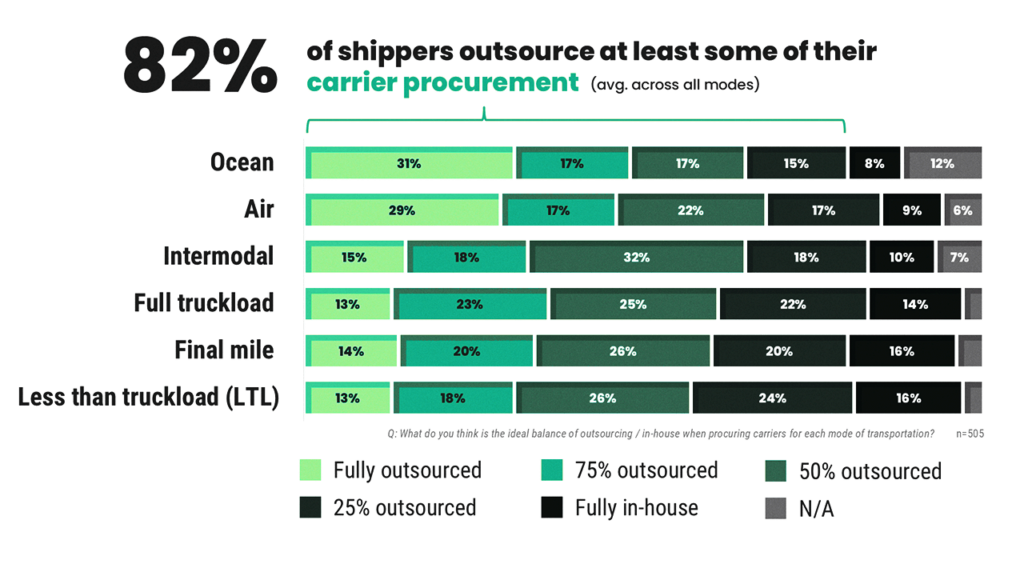
Get more insights like this by reading the full study on supply chain outsourcing.
Get Started With an LTL Quote
You can get instant access to on-demand LTL quotes and shipment booking with RXO ConnectTM, our free digital freight platform.
It’s designed to make quoting and booking freight simple.
You can view options from all types of carriers — from national to sub-regional — in one convenient platform.
